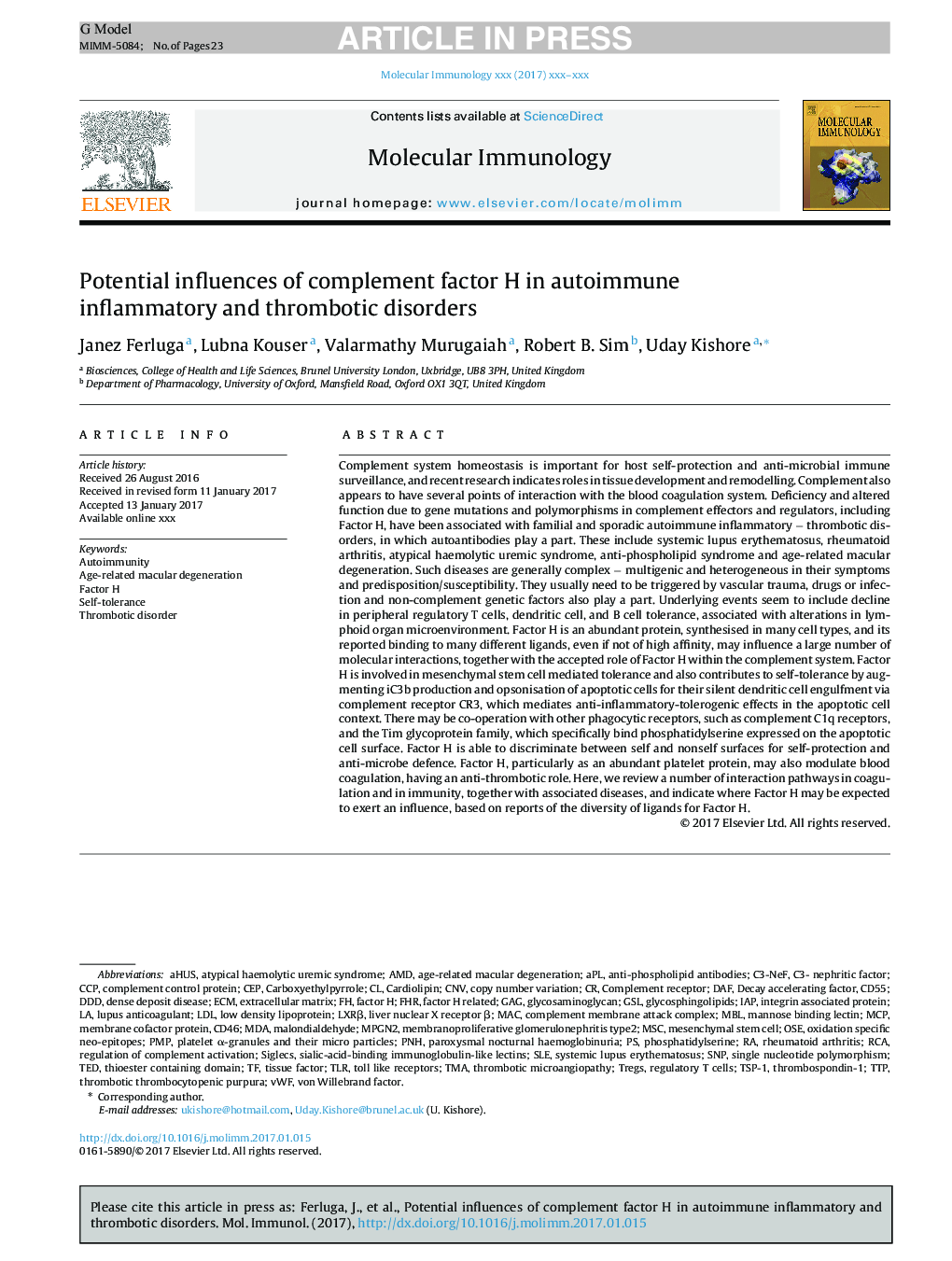| کد مقاله | کد نشریه | سال انتشار | مقاله انگلیسی | نسخه تمام متن |
|---|---|---|---|---|
| 5591964 | 1570709 | 2017 | 23 صفحه PDF | دانلود رایگان |
عنوان انگلیسی مقاله ISI
Potential influences of complement factor H in autoimmune inflammatory and thrombotic disorders
دانلود مقاله + سفارش ترجمه
دانلود مقاله ISI انگلیسی
رایگان برای ایرانیان
کلمات کلیدی
TregsMSCvWFDAFAMDTLRDDDIAPECMMBLGAGCCPAtypical haemolytic uremic syndromeTTPPNHTSP-1GSLSiglecsTEDFHRcarboxyethylpyrrolePMPRCAMDAAPLTMACNVLXRβMCPaHUS - ahusCEP - MOBILEOSE - ORRheumatoid arthritis - آرتریتروماتوئیدAnti-phospholipid antibodies - آنتیبادی ضد فسفولیپیدdense deposit disease - بیماری سپرده متراکمThrombotic thrombocytopenic purpura - ترومبوتیک ترومبوسیتوپنیک پورپوراTMA, Thrombotic microangiopathy - ترومبوتیک میکروانژیوپاتیThrombospondin-1 - ترومبوسپوندن-1copy number variation - تنوع نسخه کپیSelf-tolerance - خود تحملautoimmunity - خودایمنیMesenchymal stem cell - سلول های بنیادی مزانشیمیRegulatory T cells - سلولهای تی تنظیمکنندهage-related macular degeneration - سن تخریب ماکولا مربوط به سن استTissue factor - عامل بافتVon Willebrand factor - عامل فون ویلبراندFactor H - فاکتور HPhosphatidylserine - فسفاتیدیلسرینSystemic lupus erythematosus - لوپوس اریتماتوی سیستمیکlupus anticoagulant - لوپوس ضد انعقادSLE - لوپوس منتشر یا لوپوس اریتماتوس سیستمیکMannose binding lectin - لکتین اتصال دهنده مانوزlow density lipoprotein - لیپوپروتئین چگالی کمLDL - لیپوپروتئین کم چگالی(کلسترول بد)Extracellular matrix - ماتریکس خارج سلولیmalondialdehyde - مالون دی آلدهیدToll like receptors - مانند گیرنده هاMAC - مکParoxysmal nocturnal haemoglobinuria - هموگلوبینوری شبانه روزی پراکسیاسمیcomplement control protein - پروتئین کنترل مکملSingle nucleotide polymorphism - پلیمورفیسم تک نوکلئوتیدیSNP - چندریختی تک-نوکلئوتیدCardiolipin - کاردیولیپینGlycosphingolipids - گلیسفینگولایپید هاGlycosaminoglycan - گلیکوزآمینوگلیکانComplement receptor - گیرنده تکمیلی
موضوعات مرتبط
علوم زیستی و بیوفناوری
بیوشیمی، ژنتیک و زیست شناسی مولکولی
زیست شناسی مولکولی
پیش نمایش صفحه اول مقاله

چکیده انگلیسی
Complement system homeostasis is important for host self-protection and anti-microbial immune surveillance, and recent research indicates roles in tissue development and remodelling. Complement also appears to have several points of interaction with the blood coagulation system. Deficiency and altered function due to gene mutations and polymorphisms in complement effectors and regulators, including Factor H, have been associated with familial and sporadic autoimmune inflammatory â thrombotic disorders, in which autoantibodies play a part. These include systemic lupus erythematosus, rheumatoid arthritis, atypical haemolytic uremic syndrome, anti-phospholipid syndrome and age-related macular degeneration. Such diseases are generally complex â multigenic and heterogeneous in their symptoms and predisposition/susceptibility. They usually need to be triggered by vascular trauma, drugs or infection and non-complement genetic factors also play a part. Underlying events seem to include decline in peripheral regulatory T cells, dendritic cell, and B cell tolerance, associated with alterations in lymphoid organ microenvironment. Factor H is an abundant protein, synthesised in many cell types, and its reported binding to many different ligands, even if not of high affinity, may influence a large number of molecular interactions, together with the accepted role of Factor H within the complement system. Factor H is involved in mesenchymal stem cell mediated tolerance and also contributes to self-tolerance by augmenting iC3b production and opsonisation of apoptotic cells for their silent dendritic cell engulfment via complement receptor CR3, which mediates anti-inflammatory-tolerogenic effects in the apoptotic cell context. There may be co-operation with other phagocytic receptors, such as complement C1q receptors, and the Tim glycoprotein family, which specifically bind phosphatidylserine expressed on the apoptotic cell surface. Factor H is able to discriminate between self and nonself surfaces for self-protection and anti-microbe defence. Factor H, particularly as an abundant platelet protein, may also modulate blood coagulation, having an anti-thrombotic role. Here, we review a number of interaction pathways in coagulation and in immunity, together with associated diseases, and indicate where Factor H may be expected to exert an influence, based on reports of the diversity of ligands for Factor H.
ناشر
Database: Elsevier - ScienceDirect (ساینس دایرکت)
Journal: Molecular Immunology - Volume 84, April 2017, Pages 84-106
Journal: Molecular Immunology - Volume 84, April 2017, Pages 84-106
نویسندگان
Janez Ferluga, Lubna Kouser, Valarmathy Murugaiah, Robert B. Sim, Uday Kishore,